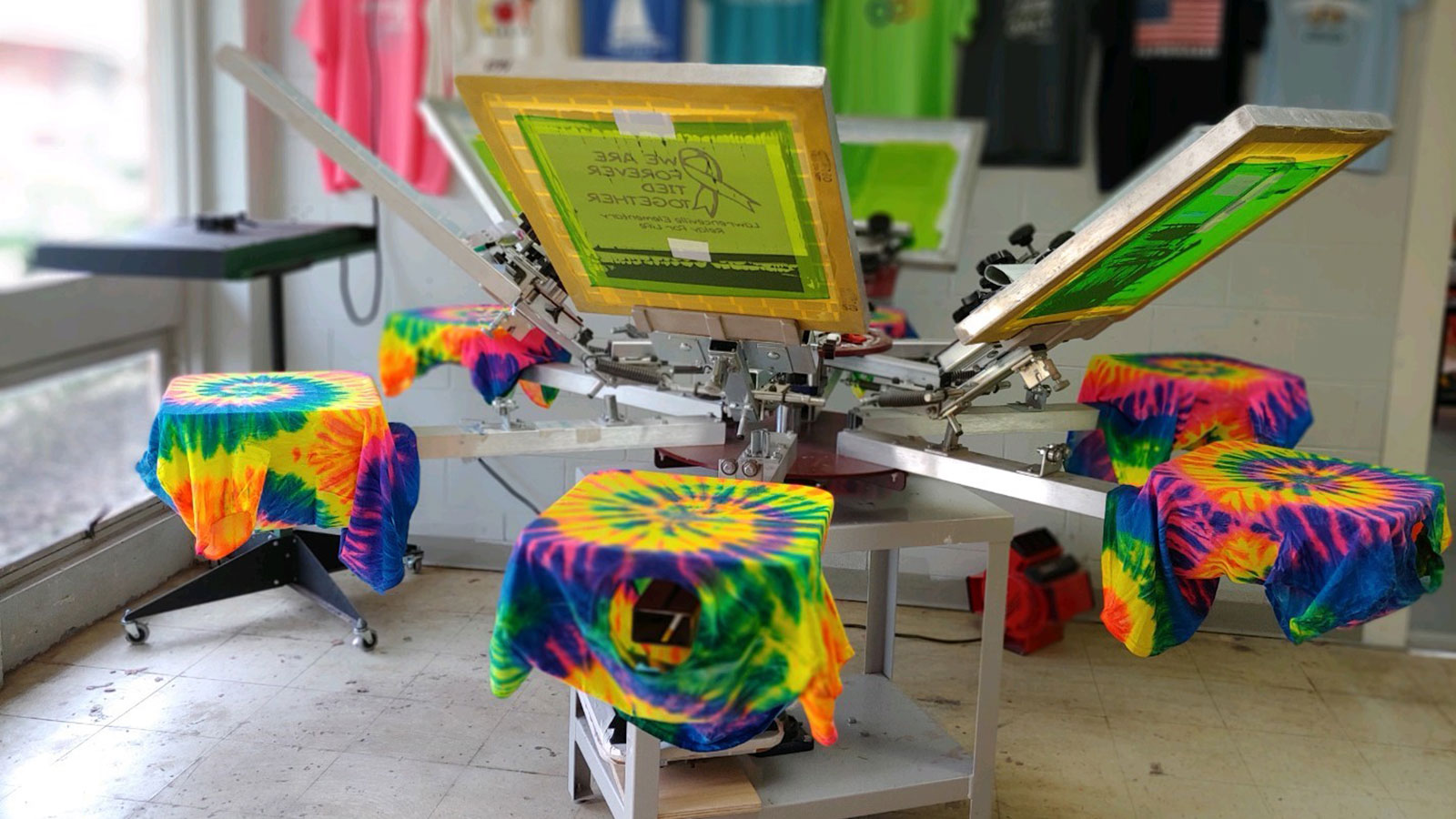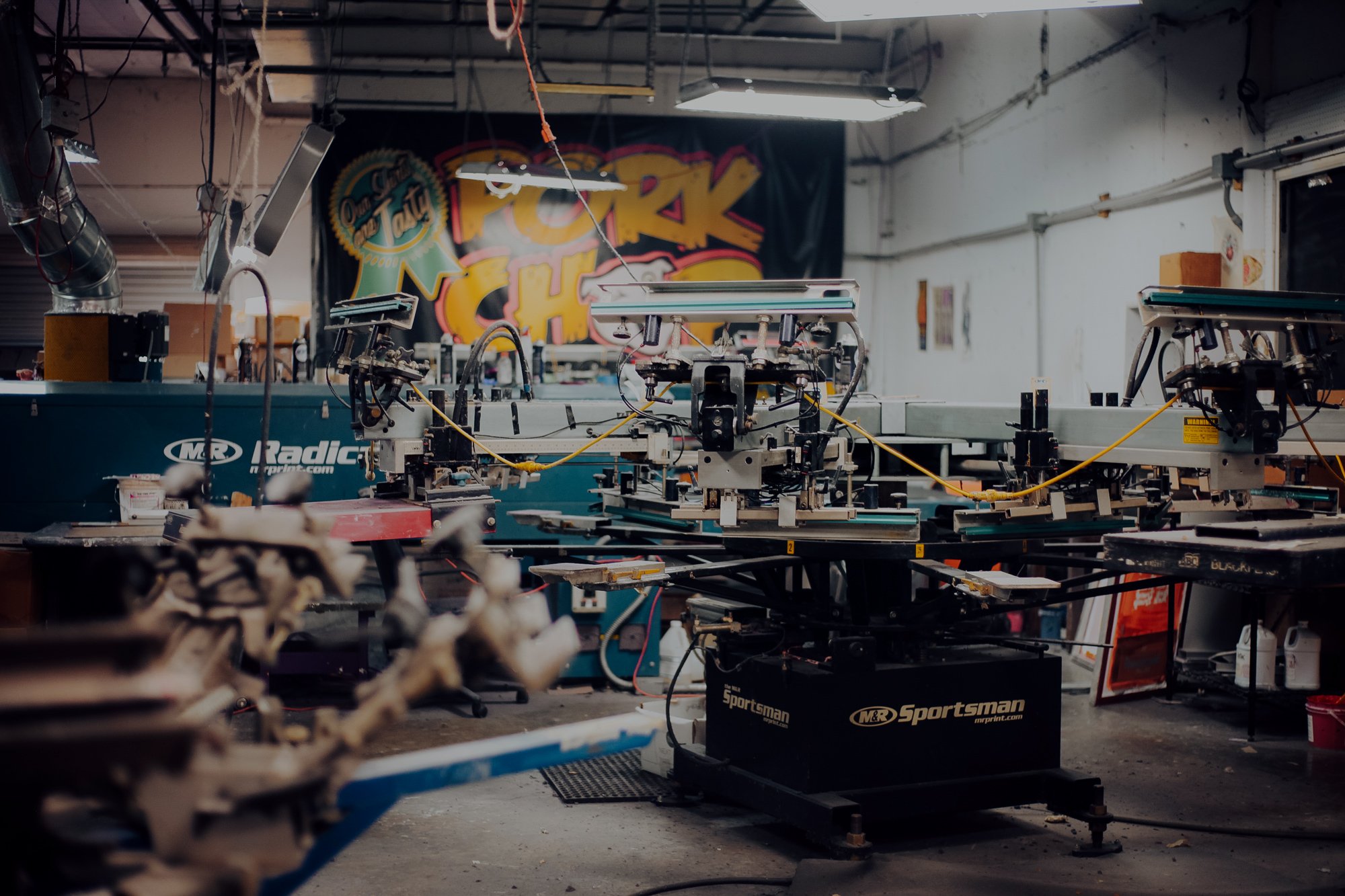Fast Turnaround Custom Screen Printing for Events
Grasping Silk Screen Printing: Advice for Creating Stunning Styles
If you're seeking to master silk screen printing, you'll require even more than just enthusiasm. It calls for a strong understanding of strategies, the right tools, and thorough preparation. You'll uncover how to prepare your art work and take on common issues that can arise during the process. By the end, you'll prepare to develop stunning designs that reflect your one-of-a-kind design. Yet first, let's discover the crucial fundamentals that prepared for your success.
Comprehending the Basics of Silk Display Printing
Silk display printing, commonly called screen printing, is a versatile method for transferring styles onto various products. You'll find it's suitable for publishing on textiles, paper, plastic, and more. The procedure involves creating a pattern, or screen, that enables ink to go through only in details locations, generating vibrant and clean styles.
To get started, you'll need to prepare your artwork, ensuring it remains in an appropriate format. screen printing kit. Once you have actually got your layout all set, you'll layer your display with a light-sensitive emulsion and reveal it to light. This action produces a pattern of your design on the screen
After rinsing the unexposed solution, you're readied to publish. Align your screen over your material, use ink, and utilize a squeegee to push the ink through the display. It's all concerning method and perseverance, so do not hesitate to experiment and improve your strategy as you go.
Crucial Tools and Products You'll Need
To get going with silk screen printing, you'll need a couple of standard supplies like screens, mops, and ink. When you fit, you can explore advanced tools that boosts your printing top quality and effectiveness. Allow's discuss what you'll call for to guarantee your projects succeed from the start.
Basic Silk Screen Products
Beginning on a silk display printing job needs a couple of crucial tools and products to guarantee your success. You'll require a silk screen frame, which holds the mesh that transfers your design. A squeegee is essential for pressing ink via the screen onto your substrate. Don't forget the ink itself; choose colors that fit your layout and the material you're printing on. A light source is important for revealing your display, in addition to emulsion to produce your stencil. You'll also need an appropriate work space, preferably one that's well-lit and free from dirt. Lastly, stockpile on cleansing materials to preserve your devices and maintain your displays in good condition. With these fundamentals, you're ready to dive right into your task!
Advanced Printing Equipment
When you're all set to take your silk screen printing to the next degree, spending in sophisticated printing devices can make a considerable difference. A top quality display printing machine is crucial; seek a multi-color press that permits for exact registration and quicker production. You'll additionally wish to update to a much more efficient direct exposure unit to assure your designs are sharp and vivid.
Consider purchasing a trustworthy warmth resource, like a conveyor clothes dryer, for even curing of inks. Do not ignore specialized inks; water-based and discharge inks offer excellent results on various textiles. A great set of mops and emulsion scoop coater will certainly enhance your procedure, giving your layouts that specialist side.
Preparing Your Art Work for Printing
Preparing your artwork for silk screen printing is essential to attaining dynamic, specialist results. Start by confirming your design is in the best style-- vector files like.AI or.EPS work best.
Once your documents prepares, create a separate layer for every shade in your style. This'll make it simpler during the printing process. Do not fail to remember to add enrollment marks to straighten colors appropriately.
Additionally, think about the mesh count of your screen; finer information might require a greater mesh count. Lastly, conserve your art work with a resolution of at least 300 DPI to assure crisp prints. By adhering to these actions, you'll set yourself up for an effective printing experience and bring your layouts to life wonderfully.
The Display Printing Process: Step-by-Step
Currently that you've prepared your art work, it's time to focus on the screen printing process itself. You'll begin by preparing your display, ensuring it awaits the ink application. From there, you'll check out different printing strategies to achieve the very best outcomes for your job.
Preparing Your Display
Getting your display prepared is a crucial step in the silk screen printing procedure. First, tidy the display completely to get rid of any type of residue, dust, or grease. Make use of a degreaser and rinse it well to guarantee a smooth surface for your solution. Next, use a light layer of emulsion uniformly across the display utilizing a scoop coater. Make certain to do this in a poorly lit area to stop premature exposure. Enable the emulsion to completely dry totally prior to exposing it to your style. When dry, put your transparency on the display and article source use a light resource to expose the style. After exposure, wash out the unexposed solution, and you'll have your display prepared for printing.
Printing Methods Described
When your display is prepared, you can plunge right into the exciting procedure of printing. Initially, area your display on your substrate-- whether it's fabric, paper, or an additional material. Safeguard it to avoid any type of movement. Next off, pour your ink onto one side of the screen and make use of a squeegee to pull the ink across the layout. Apply also pressure to ensure the ink permeates through the mesh. Raise the screen meticulously to disclose your print. Allow each layer dry before applying the next if you're layering colors. Clean your screen quickly to stop ink from drying out and obstructing the mesh. With practice, you'll master the nuances of stress and timing, which will certainly aid you achieve crisp, vibrant designs.
Tips for Getting Vibrant Color Styles
While accomplishing dynamic colors in silk display printing may appear difficult, you can conveniently boost your layouts with a few essential methods. Pick premium inks particularly made for silk display printing; they offer far better coloring and insurance coverage. Blending inks appropriately can additionally boost vibrancy-- experiment with ratios to discover the perfect blend that pops.

Finally, do not forget healing your prints appropriately. Proper heat setting assurances the colors bond with the textile, preserving their vibrancy with time. By applying these strategies, you'll produce spectacular, eye-catching layouts that really radiate.
Troubleshooting Common Printing Problems
Even with lively colors in your layouts, silk screen printing can in some cases provide obstacles. One common problem is ink bleeding, which often happens when you utilize way too much ink or do not allow the previous layer dry completely. To prevent this, utilize a squeegee with just the best stress and guarantee each layer is dry before adding more.
An additional issue is imbalance. Verify your enrollment marks and make adjustments to your displays if your style isn't lining up effectively. In addition, if you observe an absence of information, it could be due to a clogged display. Tidy your displays extensively prior to beginning your print run.
Finally, if the ink isn't adhering well to the fabric, consider the fabric kind and the healing procedure. Make certain you're using the appropriate ink and that you're healing it at the proper temperature. Repairing these common concerns will assist you accomplish sensational outcomes.
Explore Results and techniques
Trying out with various strategies and impacts can elevate your silk screen printing tasks Recommended Site to brand-new elevations. You can likewise play with appearances-- using different squeegee strategies or incorporating materials like brushes or sponges includes dimension to your prints.
Take into consideration using specialized inks, such as glow-in-the-dark or metal, to give your designs an unforeseen twist. You could even check out stenciling, where you can reduce intricate layouts for spectacular effects.
Don't forget regarding substratum variants! Printing on materials, wood, or paper can yield various results that boost your project's feeling.
Lastly, keep a journal of your experiments. Documenting your successes and failings will certainly lead your future productions and aid you refine your style. Accept the procedure, and enjoy the trip of uncovering what works best for you!
Frequently Asked Inquiries
Just how Do I Tidy and Preserve My Screen Printing Devices?
To cleanse and keep your display printing equipment, routinely scrub screens with an ideal cleaner, laundry squeegees after usage, and shop every little thing in a dry, dust-free environment. Maintaining things clean guarantees much better prints and longer-lasting devices.

Can I Publish on Materials Aside From Material?
Consider utilizing paper, plastic, or wood. Simply make certain your screens and inks are suitable with those surface areas for the best results.
What Is the most effective Way to Store Screens and Inks?
To store inks and displays effectively, keep screens upright in an awesome, dry area, and cover them to avoid dirt. Shop inks in impermeable containers, far from straight sunshine, to keep their quality and uniformity.
Exactly how Do I Select the Right Mesh Count for My Project?
Selecting the best mesh matter depends upon your design's detail and ink kind. For great information, go higher, like 200 mesh (screen printing kit). For strong designs, a reduced matter, around 110, works finest. Experiment to discover your perfect match.
What Are the Environmental Impacts of Silk Display Printing?
Silk screen printing can have environmental effects, like chemical waste and water use. You can decrease these by utilizing green inks, reusing products, and properly getting rid of chemicals to reduce your project's eco-friendly impact.
Silk screen printing, usually called display printing, is a flexible this technique for moving designs onto different products. Align your screen over your material, apply ink, and make use of a squeegee to push the ink through the display.To obtain begun with silk screen printing, you'll need a few standard materials like displays, mops, and ink.When you're prepared to take your silk screen printing to the next degree, spending in sophisticated printing tools can make a considerable difference.Obtaining your screen all set is a vital action in the silk display printing process.